 Global Information
Global InformationList of medieval armour components information
This article does not cite any sources. (April 2021) |

This list identifies various pieces of body armour worn from the medieval to early modern period in the Western world, mostly plate but some mail armour, arranged by the part of body that is protected and roughly by date. It does not identify fastening components or various appendages such as lance rests or plumeholders, or clothing such as tabards or surcoats, which were often worn over a harness.
There are a variety of alternative names and spellings (such as cowter or couter; bassinet, bascinet or basinet; and besagew or besague) which often reflect a word introduced from French. Generally, the English spelling has been preferred (including mail instead of the lately used maille or the inauthentic term chainmail). The part of armour on the hand is called the gauntlet, which is based on a French word.
| Name | Example | Period (Century) |
Description |
|---|---|---|---|
| Head | |||
| Mail coif |  |
400BC? to 15th | Mail hood, often worn with a hauberk. Sometimes made integrally with the hauberk, sometimes a separate piece. |
| Spangenhelm |  |
4th to 11th | A metal (usually iron) frame with plates (metal, leather or horn) riveted to the inside; some had hinged or laced cheekguards. Standard helm from late antiquity through the early Middle Ages. |
| Nasal helmet |  |
Late 9th to 13th | The nasal helmet was characterised by a nose guard, or 'nasal', composed of a single strip of metal that extended down from the skull or browband over the nose to provide partial facial protection. This helmet appeared throughout Western Europe in the late 9th century, and became the predominant form of head protection until the enclosed helmet and great helm were introduced in the 12th and early 13th century. |
| Enclosed helmet |  |
Late 12th to early 13th | Forerunner of the great helm. The enclosed helmet covered the entire head, with full protection for the face and somewhat deeper coverage for the sides and back of the head than that found on previous types of helmets. It was developed near the end of the 12th century and was largely superseded by the true great helm by c. 1240. |
| Great helm |  |
Late 12th to 14th | Started as a simple cylinder with a flat top but later developed a curved "sugar loaf" pointed top to deflect crushing blows. Has small slits for vision and breathing and ventilation which may be decorative as well as functional. Often removed after the initial "clash of lances" as it impeded sight and breathing and was very hot. Often worn with another helm underneath. A stereotypical knight's helm from the Crusader period. |
| Cervelliere |  |
Late 12th | Steel skull cap worn as a helm or underneath a great helm. Sometimes worn under rather than over the coif. |
| Bascinet |  |
Early 14th to early or mid 15th | Originally worn underneath a great helm and had no visor but did develop nasals to protect the nose. By the mid-14th century it replaced the great helm and was fully visored, often "dog-faced" (the conical hounskull visor), but often worn without the visor for improved visibility ventilation. Worn with an aventail then later with a gorget. Visors on English bascinets have a hinge at each side whereas German bascinets have a single hinge attached at the middle. |
| Sallet |  |
Mid-15th | When worn with a bevor as was usual outside Italy, a sallet covers the entire head. The Italian version was a curvaceous helmet with a short tail, and was sometimes provided with a 'bellows visor'. The German sallet was distinguished by a long, sometimes laminated, tail that extended to cover the back of the neck and by a single, long eye slit. It had no ventilation holes as there was a gap where the helm and bevor meet. The sallets of England, the Netherlands and France were intermediate between the Italian and German forms, with a short tail. A favoured helm in England and Western Europe, including Germanic areas (the tail may have influenced design of 20th century German helmets). |
| Barbute |  |
15th | Close fitting helmet with a characteristic Y- or T-shaped slit for vision and breathing, reminiscent of ancient Greek helmets |
| Armet | 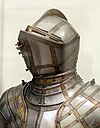 |
15th | A bowl helmet that encloses the entire head with the use of hinged cheek plates that fold backwards. A gorget was attached and a comb may be present. May also have a rondel at the rear. Later armets have a visor. A stereotypical knight's helm. Favoured in Italy. |
| Close helmet or close helm |  |
15th to 16th century | A bowl helmet with a moveable visor, very similar visually to an armet and often the two are confused. However, it lacks the hinged cheekplates of an armet and instead has a movable bevor, hinged in common with the visor. |
| Burgonet |  |
Early 16th | Open face bowl shaped helmet with a neck collar, a peak, a very characteristic comb, sometimes with cheek pieces. Sometimes has a buffe (a visor that is lowered, rather than raised). |
| Neck | |||
| Aventail or camail |  |
Detachable mail hung from a helmet to protect the neck and shoulders, often worn with bassinets. | |
| Bevor |  |
Worn with a sallet to cover the jaw and throat (extending somewhat down the sternum). May also cover the back of the neck if worn with a bassinet rather than a sallet. May be solid or made of lames. Sometimes worn with a gorget. | |
| Gorget |  |
Steel collar to protect the neck and cover the neck opening in a complete cuirass. Quite unlike a modern shirt collar in that as well as covering the front and back of the neck it also covers part of the clavicles and sternum and a like area on the back. | |
| Standard, pixane, or bishop's mantle |  |
A mail or leather collar. In common with a gorget, it is not like a modern shirt collar. Rather, it is a circle with a hole for the neck to fit through. It covers the shoulders, breast and upper back, perhaps like an extremely small poncho. | |
| Torso | |||
| Brigandine |  |
late 12th to 16th | Cloth garment, generally canvas or leather, lined with small oblong steel plates riveted to the fabric. |
| Hauberk, byrnie, or haubergeon |  |
? to 15th (mostly died out during the 14th and 15th centuries) | Mail shirt reaching to the mid-thigh with sleeves. Early mail shirts generally were quite long. During the 14th–15th century hauberks became shorter, coming down to the thigh. A haubergeon reaches the knee. The haubergeon was replaced by the hauberk due to the use of plate; with the legs now encased in steel, the longer mail became redundant. |
| Cuirass | 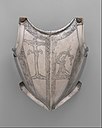 |
14th to 17th | Covers the chest, not the back, but the name is sometimes used to describe the chest and back plates together. Developed in antiquity but became common in the 14th century with the reintroduction of plate armour, later sometimes two pieces overlapping for top and bottom. Whether of one piece or two, breastplate is sometimes used to literally describe the section that covers the breast. |
| Plackart |  |
Extra layer of plate armour initially covering the belly. Often decorated. Worn as part of a cuirass. | |
| Faulds | 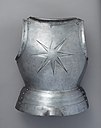 |
Bands to protect the front waist and hips, attached to cuirass. | |
| Culet |  |
Small, horizontal lames that protect the small of the back or the buttocks, attached to a backplate or cuirass. | |
| Arm | |||
| Couter or cowter |  |
Plate that guards the elbow. Eventually became articulated. May be covered by guard of vambrace (see below). | |
| Spaulder | 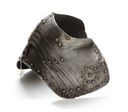 |
Bands of plate that cover the shoulder and part of upper arm but not the armpit. | |
| Pauldron |  |
15th | Covers the shoulder (with a dome shaped piece called a shoulder cop), armpit and sometimes the back and chest. |
| Gardbrace | 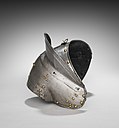 |
Extra plate that covers the front of the shoulder and the armpit, worn over top of a pauldron. | |
| Rerebrace or brassart or upper cannon (of vambrace) |  |
Plate that covers the section of upper arm from elbow to area covered by shoulder armour. | |
| Besagew | 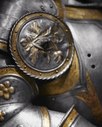 |
Circular plate that covers the armpit, typically worn with spaulders. See also rondel. | |
| Vambrace or lower cannon (of vambrace) |  |
14th | Forearm guard. May be solid metal or splints of metal attached to a leather backing. Bracers made of leather were most commonly worn by archers to protect against snapping bowstrings. Developed in antiquity but named in the 14th century. 'Vambrace' may also sometimes refer to parts of armour that together cover the lower and upper arms. |
| Gauntlet |  |
Gloves that cover from the fingers to the forearms, made from many materials. | |
| Guard of vambrace |  |
An additional layer of armour that goes over cowter, in which case it is proper to speak of the lower cannon of the vambrace which is the forearm guard, and the upper cannon of vambrace which is the rerebrace. | |
| Leg | |||
| Chausses | Mail hosen, either knee-high or covering the whole leg. | ||
| Poleyn |  |
13th | Plate that covers the knee, appeared early in the transition from mail to plate, later articulated to connect with the cuisses and schynbald or greave. Often with fins or rondel to cover gaps. |
| Schynbald | 13th to 15th | Antiquity, lost but later reintroduced. Plate that covered only the shins, not the whole lower leg. | |
| Greave |  |
Covers the lower leg, front and back, made from a variety of materials, but later most often plate. | |
| Cuisse |  |
Plate that cover the thighs, made of various materials depending upon period. | |
| Sabaton or solleret |  |
Covers the foot, often mail or plate. | |
| Tasset or tuille | 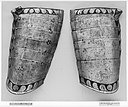 |
Bands hanging from faulds or breastplate to protect the upper legs. | |
| Various | |||
| Gousset | 14th | Mail that protects areas not covered by plate. | |
| Lame |  |
Band of steel plate, put together severally so that several bands can articulate on various areas like around the thighs, shoulders or waist. Such pieces are named for the number of bands, for instance, a fauld of four lame. | |
| Arming doublet or gambeson | Padded cloth worn under a harness. | ||
| Rondel |  |
Any circular plate. Rondels protecting various areas may have particular names, such as a besagew protecting the shoulder joint. | |